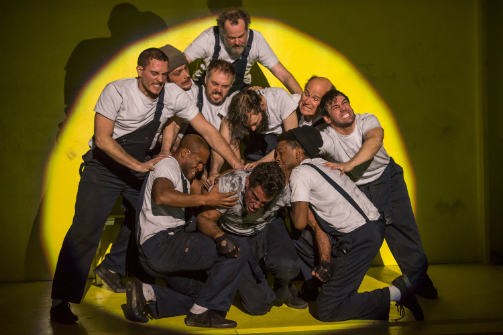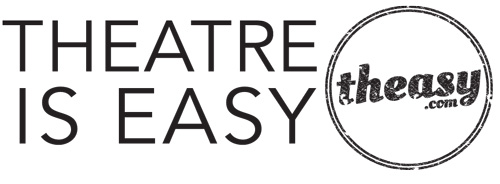
The Hairy Ape
By Eugene O'Neill; Directed by Richard Jones
Produced by Park Avenue Armory and Old Vic London
Off Broadway, Play Revival
Runs through 4.22.17
Park Avenue Armory, 643 Park Avenue
by Ran Xia on 4.9.17
 The company in The Hairy Ape. Photo by Stephanie Berger
The company in The Hairy Ape. Photo by Stephanie Berger
BOTTOM LINE: A spectacular revival of Eugene O'Neill's masterpiece about identity and class struggle is stylized to the nines, yet misses the opportunity to be searing social commentary.
Stepping into the grandeur of the Park Avenue Armory, you feel almost intimidated by the lavishly decorated corridors and marble staircases, until your entire visage is filled with, no, invaded by, yellow. Specifically, a cascade of 800 sulfur-yellow chairs, each cradling a program with matching yellow cover: it's sickeningly vibrant, deafeningly loud, and dazzling with its unapologetic, almost savage beauty. It's Fauvist yellow, and now you’re a part of it, amidst the surreal world of Richard Jones' production of The Hairy Ape. As designed by Stewart Laing, who uses no more than two colors, mostly primary, in each scene, the end result is stark, saturated, and almost too powerful to behold.
The Hairy Ape debuted in the swinging 20s, birthed out of the same angst that fueled Rilke, Kafka, and Klee. New York City had recovered from the shock of the 1913 Armory Show, which introduced to the world the idea that art doesn’t have to be pretty. There were polarizing responses. Some people got riled up so much that they burned effigies of Matisse’s Blue Nude. But for some, it also blasted open new creative frontiers: there was Munch and that soul-wrenching scream; Kandinsky and abstract art; and Eugene O’Neill and his expressionist plays, including The Hairy Ape, a play that possesses the duality of savage and exquisite that's the core of all expressionist creations, and is still relevant after almost 100 years.
The Hairy Ape is about class struggle and identity. It tells a not-so-complex story with vastly complex characters, where the protagonist's failing pursuit of a sense of belonging becomes a recurring theme. The play starts in the forecastle of a cruise ship owned by a steel magnate. In Jones's production, the stokers are brought before the audiences via an enormous conveyor belt that circumscribes the audience. Among the stokers, confined within a steel shipping container-sized box (that same sulfur yellow), is Robert "Yank" Smith (Bobby Cannavale)—the brutish "leader" of the crew. He stands out with an imposing physique, as well as an aura of superiority. The men listen when he barks "shut up! I’m trying to ‘tink’!" His pose—an imitation of Rodin’s The Thinker—becomes a motif that mocks his lack of intellect.
Above the deck, Mildred Douglas (Catherine Combs), daughter of the company's CEO, plays the “misunderstood ingénue” with deliberate exaggeration. Dressed in all white with a silver scarf, which she waves around above her head, she represents the polar opposite of the men down below. Mildred announces to her aunt (Becky Ann Baker), whose buttoned up steel-blue dress coat is as unyielding as the gigantic letters that spell out Douglas Steel, that she has decided to pay a visit to the workers. Back in the stokehold, the “meet cute” of the poster children from two drastically different classes unfortunately ends with Mildred fainting at the sight of Yank, the filthy beast, the “hairy ape.” Yank’s obsession with Mildred thus begins. "I have fallen in hate, get me?" he says, but is countered by Paddy’s (David Costabile) comment that Yank has fallen in love with Mildred: “’Twould take a wise man to tell one from the other.”
As Yank continues his journey ashore, he becomes increasingly isolated. Initially accompanied by Long (Chris Bannow), an Englishman who believes in socialism, and then later on his own, Yank clashes not only with the bourgeois class on Fifth Avenue, but also with the "wobblies" at the I.W.W. (Industrial Workers of the World), the union he joins in an attempt to find kindred spirits. Ironically, Yank calls Long, as well as everyone else he finds cowardly, "yellow." The term of insult was first used in the 19th century, and within the context of the early 20th century (when the play is set), employers would have new hires sign a pledge to never join a union. Union members used to call it a “yellow dog” contract (since anyone who signs it would be "yellow".)
The tragedy of The Hairy Ape is without a doubt the degeneration of Yank, both emotionally and mentally. Cannavale's Yank is a breathtaking presence. He convincingly portrays the earnest hothead who painfully lacks teamwork skills, and whose spirit ultimately disintegrates into despair. In the heartbreaking final scene, Yank goes to the zoo to seek understanding and possibly companionship in a gorilla (whose cage is quite similar to the rooms where the stokers lived and worked). "Dey don’t belong wit me, dat’s what. Get me?" Yank says to the beast, in a tone that makes you think of the moment when Coriolanus says to the whole city, "I banish you."
Jones's interpretation of the text is a playwright's wildest dream coming true, with every motif and symbolism, even the most obscure ones, elaborated on stage. The surrealistic language used between the characters come off as the most natural—you believe this is exactly the way coal stokers talk to each other. Choreographer Aletta Collins creates an otherworldly yet grounded movement vocabulary, blurring the line between reality and a Daliesque dreamscape: each formation of the stokers in their "cage" looks like a skillfully composed tableau out of a Tarsem Singh film. In a later scene, as society folk surround Yank in a fascinating, grotesque dance, their yellow gloves, yellow shoes, and plaster white masks make them look like figures in an Edward Gorey illustration.
It's difficult to recount all the good things about this production. However, with only two black actors in nameless and mostly silent parts, the lack of diversity onstage diminishes the play's potential for searing social commentary. Yank's rant on the street is familiar. You hear similar ones—in the middle of the night, at the break of dawn, on subway platforms, in moving trains, or out on the streets—from the angry, the exhausted, and the starving. Some are veterans who have given their all, or workers who are barely surviving on minimum wage; some are mentally ill, homeless, and sick. Most of them are black. And they're treated with contempt, rejection, and fear. Well-dressed residents of doorman buildings stay away, or frown and subtly hold their breath when "the filthy beasts" stink up a whole room. "Enuf to gimme life for! I was born, see?" Yank utters the most heartbreaking line of the play, pleading with the police to lock him up in a cage, since he doesn't seem to belong anywhere. Yet it is difficult to associate Cannavale's face, even if covered in dirt, with this notion of society's refuse.
The physical description of the characters in The Hairy Ape has always led to a debate regarding the race of Yank—whose face is covered with black coal dust. In 1930, a London production featured Paul Robeson as the first black actor to play the part. Of course, it coincided with the Anglo-Irish tension in Europe, making the casting choice less controversial than say, if it had happened in the US. While the play is never overtly about racial tension, this is nevertheless an issue closely connected with the central theme of class disparity. The play's angst is deeply rooted in the reality it came out of, and the beauty of its abstraction lies in its potential to evolve through time. Because of this quality, The Hairy Ape helped make O'Neill one of the most important American playwrights. However, an interpretation of a piece of art is about more than resurrecting a historical relic. This production is a brilliant and faithful translation of everything on Eugene O'Neill's pages (and then some), complete with thoroughly captivating visual design and a team of masterful performers. Still, it's a missed opportunity for the production to shy away from what it is equipped for, which is to give voice to, and represent, the refuse of our 21st-century American society.
(The Hairy Ape plays at Park Avenue Armory, 643 Park Avenue, through April 22, 2017. The running time is 1 hour 30 minutes with no intermission. Performances are Tuesdays at 7:30; Wednesdays at 2 and 7:30; Thursdays at 7:30; Fridays at 8; Saturdays at 2 and 8; and Sundays at 2. Tickets are $30 – $195 and are available at armoryonpark.org or by calling 212-933-5812.)
The Hairy Ape is by Eugene O'Neill. Directed by Richard Jones. Choreography is by Aletta Collins. Production Design is by Stewart Laing. Lighting Design is by Mimi Jordan Sherin. Additional Music and Sound Design is by Sarah Angliss. Fight Director is Thomas Schall. Dialect Coach is Kate Wilson. Production Stage Manager is Thom Widmann. Stage Manager is Matthew Leiner.
The cast is Bobby Cannavale, David Costabile, Becky Ann Baker, Catherine Combs, Chris Bannow, Tommy Bracco, Emmanuel Brown, Nic Bruder, Phil Hill, Cosmo Jarvis, Mark Junek, Henry Stram, Jamar Williams, Isadora Wolfe, and Amos Wolff.

